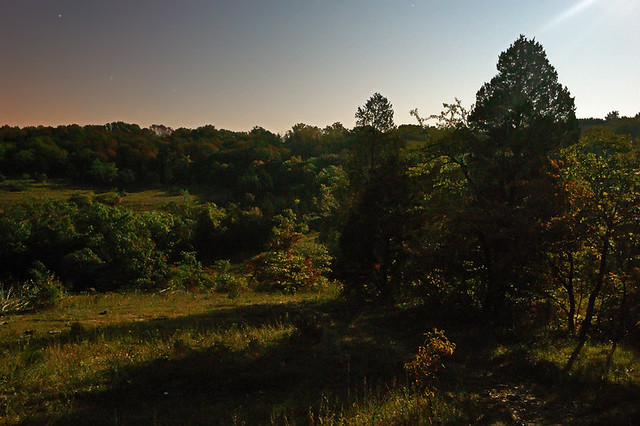|
Friday, September 23, 2011
Newsletter from the Oratory

Labels:
events
Location:
Saint Francis de Sales Oratory
Photos of Fog
LESS THAN A WEEK ago, I remembered the dense fog of northern California. “We never get that kind of fog in Saint Louis,” I thought. But providentially, the weather forecast predicted heavy fog over large parts of the Midwest. So I got up before dawn and took my camera to shoot some pictures.
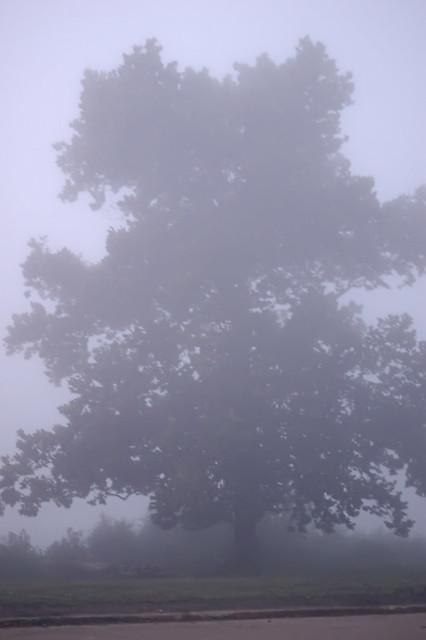
At North Riverfront Park in Saint Louis.
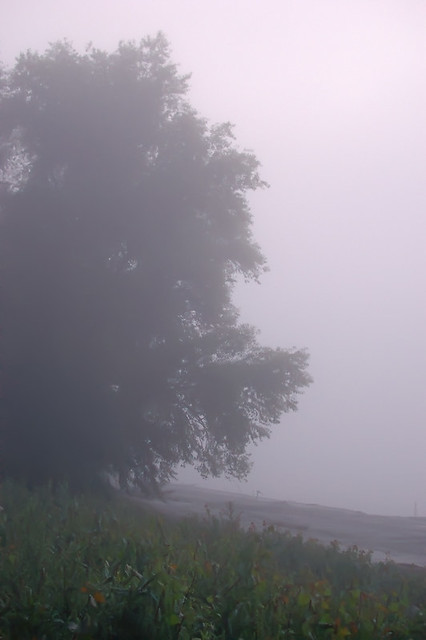
Photography within fog does not obey the rules of the photographic Modernists: sharpness, great depth of field, and precise focus are impossible and pointless. Rather, we follow the earlier Pictorialist photographers, seeking strong composition and an emotional or even a spiritual approach to our subject.
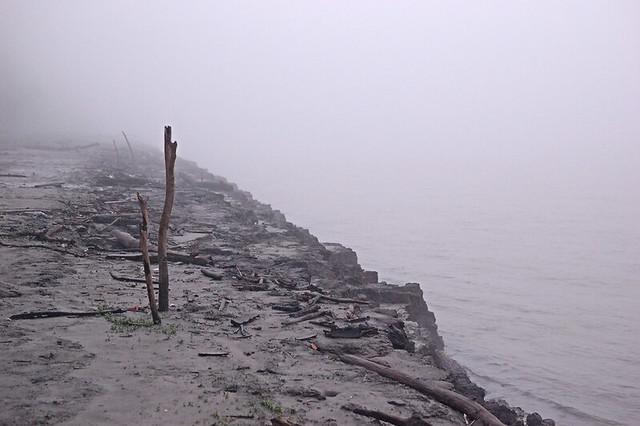
Fog shrouds large things, like the greatest river in North America in this photo, or huge mountain ranges; it can also cover things of practical importance, like an oncoming vehicle on the road.
Fog is a natural symbol of unknowing, of the heavy veil that separates our experience and knowledge from reality. Sharp edges are lost, colors are muted, and our view is severely limited.
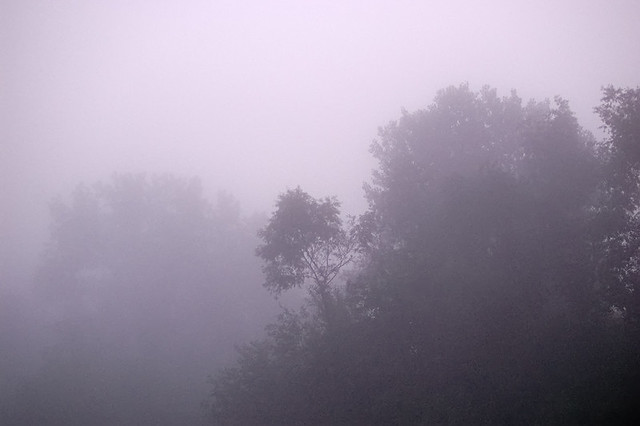
Fog is a cloud that has settled or has formed on the ground. Normally clouds have no obvious scale, they appear to be floating beneath a heavenly dome to which are affixed the stars, and so could be any distance away: our eyes give us little clue.
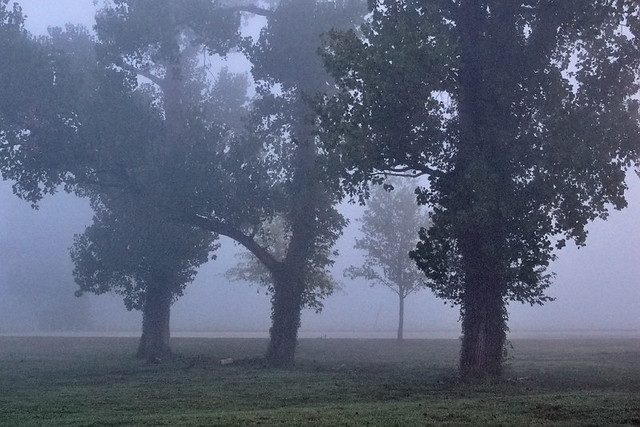
But when fog settles near the ground, you can sometimes reach up and touch that cloud's base, or even stand above it if it is not too thick. Within the cloud, your senses are confused: you cannot see far, your hearing is muffled, and the odor of the cloud itself, the humidity, fills your nostrils and you can even taste it and feel it.
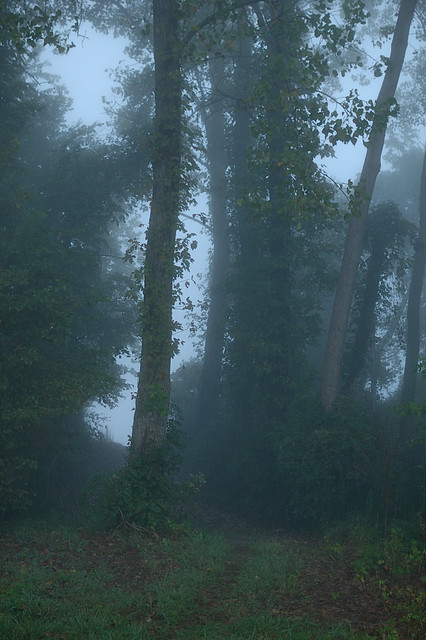
At Columbia Bottom Conservation Area, located at the confluence of the Mississippi and Missouri Rivers.
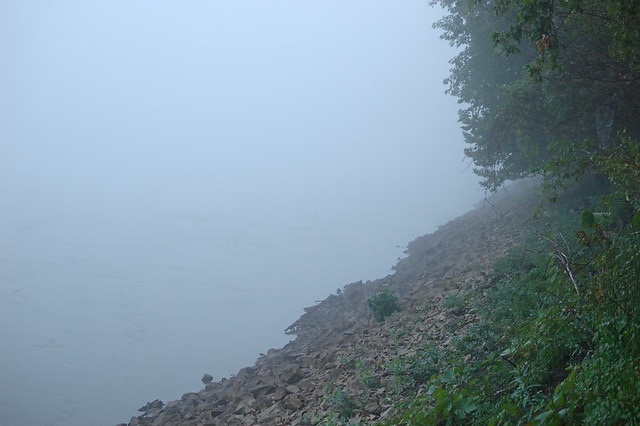
Clouds are a symbol of divinity. God leads the Israelites as a pillar of cloud. The glory of God, shrouded by clouds, settles on Mount Sinai and on the Tabernacle. Mist, mystically speaking, is a symbol of the intersection of the divine and earthly.

In Sacred Scripture, clouds veil God from our sight, and are also a symbol for God's gifts: as rain from the clouds relieves a parched land, so grace refreshes our souls.
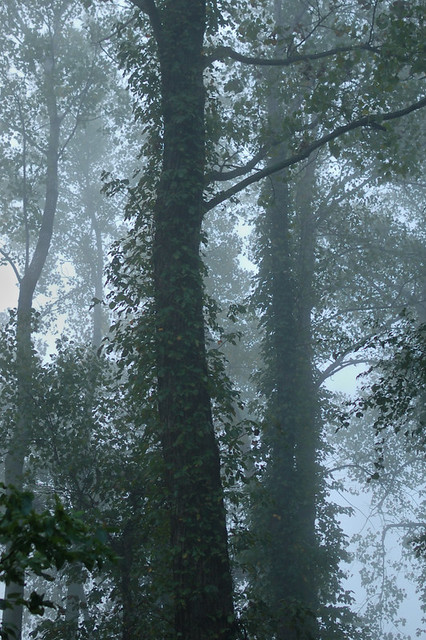
In fiction, the symbolism of fog can be used to good effect. The hard-boiled detective Sam Spade in San Francisco, and Sherlock Holmes in London, both seek out the answers to mysteries in the dark and the fog.
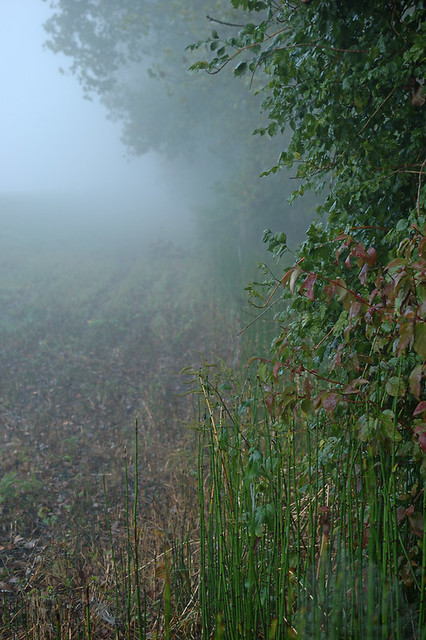
In more romantic styles of fiction, fog can have a presence, almost if it were a character in the story. What lurks nearby, unseen?
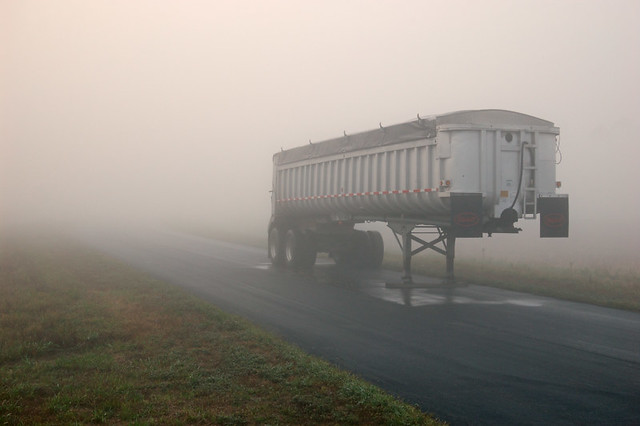
It is said that climate shapes character, as well as philosophy. The ancient Greeks preferred bright days of sunshine, and likewise their high philosophy is seen as being overly optimistic at man's ability to shape history and approach divinity. Northern stories and philosophies, set amid the cold and fog, tend to be more pessimistic, more dependent on unalterable fate.
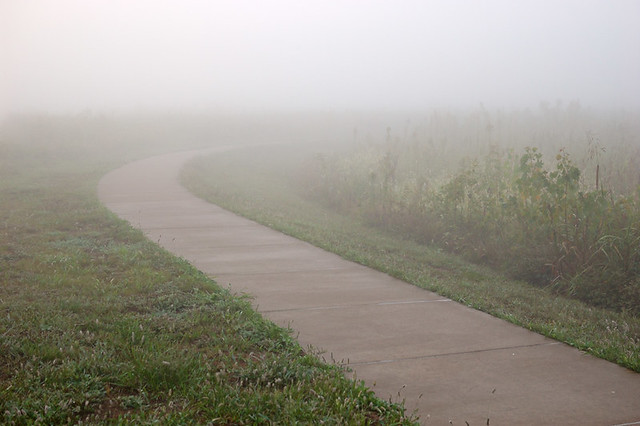
There is a common contemporary philosophy that does not want to approach mystery. Especially when it comes to religion, this view accepts mysteries such as the Holy Trinity, but does not attempt to go deeper into them. Rather, these philosophers concentrate on practical matters, such as politics.
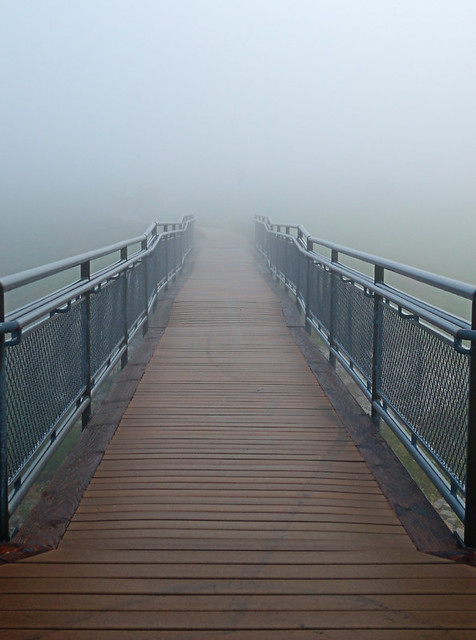
It is true that a fog restricts our vision, and the fog of divinity likewise veils our theology. As Saint Paul writes, we see through a glass, darkly. But to a traveler who must reach his final destination, fog must be navigated whether he wants to or not, despite his own personal standards for acceptable visibility.
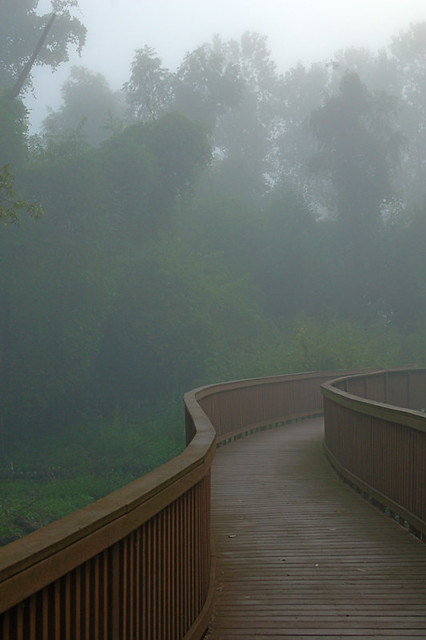
And so likewise, we must navigate the fog of divinity if we want to reach our final destination. As Christians, we ought to humbly accept Revelation, as a driver must rely on his roadmaps when traveling though unknown territory.

Labels:
faith,
nature,
philosophy,
photos
Location:
Columbia Bottom Conservation Area
Wednesday, September 21, 2011
A Spiderweb

Location:
Columbia Bottom Conservation Area
Monday, September 19, 2011
"Theological Aspects of Beauty and Art"
MEET ME this Friday, when I talk about art and beauty:
SPEAKER SOCIAL
September 23
Doors Open 6:30 pm / Speaker Begins 7:00 pm
MARK SCOTT ABELN
"Theological Aspects of Beauty & Art"
|
Please j
 oin us this Friday, when Mark Abeln, speaks to us on Catholic tradition in art (classical and medieval), the virtue of art, and the traditional definitions of art and beauty. oin us this Friday, when Mark Abeln, speaks to us on Catholic tradition in art (classical and medieval), the virtue of art, and the traditional definitions of art and beauty.
A native St. Louisan and Catholic convert, Mark Abeln is a professional photgrapher, and has also been writing about Catholic culture since 2004 in his online blog, Rome of the West. While taking photos of some old churches, Mark became aware that his poor-qualtiy photos did not do justice to these worthy subjects, and so he was inspired to learn the art of photography, and the role of religion in contemporary culture. This ultimatey culminated in the publication of Fr. William Barnaby Faherty's book Catholic St. Louis: A Pictorial History, which featured hundreds of Mark's color photographs of area churches.
Coffee, Cappuccino, Espreso & More!
Catholic St. Louis: A Pictorial History
will be available for purhase!

No Cost - Goodwill Offering Appreciated!

Woodstone Plaza
636-447-6000
|
Photos of Immaculate Conception Church, in Saint James, Missouri
HERE ARE PHOTOS of Immaculate Conception Church, in Saint James, Missouri. The church is located in Phelps County, and is about 97 miles southwest of downtown Saint Louis on Interstate 44. It is part of the Diocese of Jefferson City.
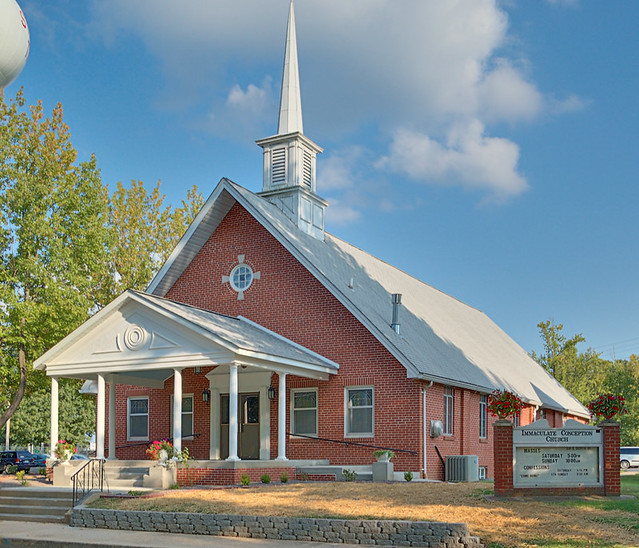
The parish was founded in 1870, and is made up about about 190 families.
The town of Saint James is not named after the Greater or Lesser Apostles of Our Lord, but rather after the James family, who owned an iron mine and smelter southeast of town. The remains of the ironworks can be found at the Maramec Spring Park. Saint James is located on Big Prairie; prior to European settlement, this area was frequented by the Shawnee tribe who had a cemetery here. The town of Scioto was laid out in 1859, being renamed Saint James the next year.
This region was settled by Italian immigrants in 1898, who set up a significant wine and grape industry. There a number of fine wineries nearby.
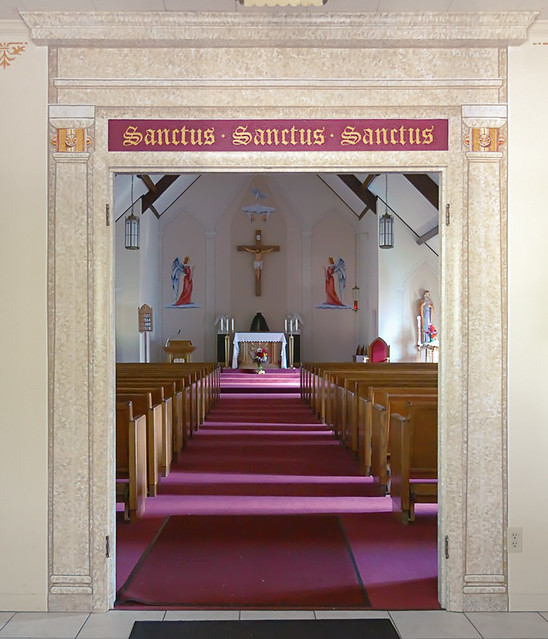
Sanctus, Sanctus, Sanctus: Holy, Holy, Holy.
The church was locked, but I was able to get this photo through the door.
Address:
316 East Scioto Street
Saint James, Missouri 65559
Monday, September 12, 2011
Moonlight

Location:
Valley View Glades Natural Area
Most Holy Name of Mary
SINCE JULY 14th, 1683, the forces of the Ottoman Empire held the city of Vienna in siege with an army of about 150,000. The commander of the Ottoman forces attempted to force its population into submission, as nearby cities already had done.
Formally at peace for twenty years with the Holy Roman Empire, the Islamic Ottomans had long made preparations for invasion: building roads, bridges, and supply depots leading to strategic targets in Christendom. While this did not go unnoticed in the West, internal division among the Christians did not help matters.
On September 11th, John III Sobieski, the King of Poland, arrived at Vienna, and swept down on the Ottomans with the largest calvary attack in history. The Christian forces largely won the battle after three hours, with full victory coming on the next day. This defeat severely depleted the Ottomans, and so this was the last incursion of the Ottoman Empire into Europe.
Sobieski gave credit to the intercession of the Blessed Virgin Mary, under her title of Our Lady of Częstochowa. In recognition of this victory, Pope Innocent XI extended the feast of the Most Holy Name of Mary to the entire Church. It is held each year on September 12th in the Roman Rite; removed from the liturgical calendar in 1969, it was restored to the liturgy in 2002.
The icon of Our Lady of Częstochowa is popularly known as the Black Madonna, due to the dark complexion of the Blessed Virgin and Christ Child.
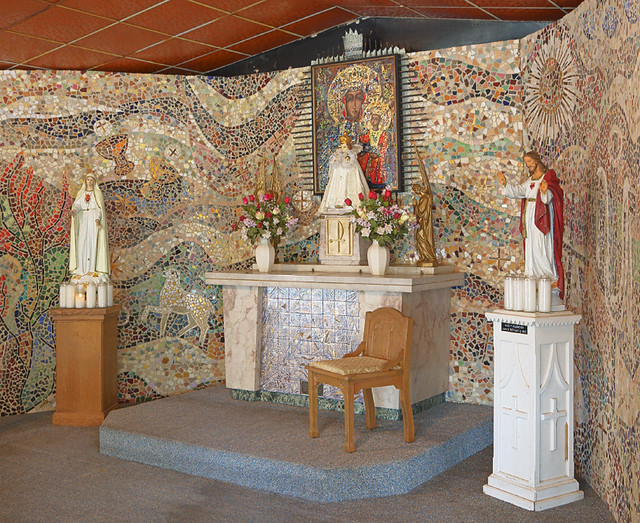
A reproduction of this icon can be seen above the tabernacle at the outdoor chapel of the Black Madonna Shrine, located south of Eureka Missouri. (Photo taken in 2008.)
Saturday, September 10, 2011
"Rosalind Moss Becomes Mother Miriam of the Lamb of God "
SEE THE ARTICLE: In the Sight of Angels and of Men. From the article:
Foundress, Rosalind Moss, in religion Mother Miriam of the Lamb of God received the traditional Benedictine habit, given that the Daughters of Mary, Mother of Israel's Hope have begun to follow the age-old Rule of Saint Benedict.
Thursday, September 08, 2011
Newsletter from the Oratory
|

Labels:
events
Location:
Saint Francis de Sales Oratory
New Lecture Series
A NEW LECTURE series, Man Elevated to Share in the Divine Life, will be given by Dr. Lawrence Feingold at Boland Hall of the Cathedral Basilica of Saint Louis, starting September 21st.
This is Dr. Feingold's 9th lecture series; his older lectures can be found here.

Labels:
faith,
people,
philosophy
Location:
Boland Hall
Wednesday, September 07, 2011
Water Lilies



Found at the Missouri Botanical Garden.
Water lilies and related flowers were recognized in Europe and the Mediterranean region as symbols of purity, the resurrection, and spiritual illumination, and white versions been called the “Lady of the Lake” as a symbol of the Blessed Virgin.
Monday, September 05, 2011
On Labor
“SOCIAL JUSTICE.” You keep using that phrase. I do not think it means what you think it means.
In the nineteenth century, appalled by the poor conditions of the working class in the cities, revolutionaries fought for structural changes in society. At that time, there was a strong division between the working classes who labored in the factories of the bourgeois capitalists. The revolutionaries intended to balance the equation more in favor of labor, typically by creating strong labor unions which would agressively pursue the interests of the working class in opposition to the capitalists.
But how did this division between labor and capital come about? It was the revolutionaries themselves that did it. They caused the problem in the first place. They must accept the blame. May God have mercy on the souls of revolutionaries past, who caused so much misery. May God convert the hearts of living would-be revolutionaries so that they do not cause more problems in the future.
The division between labor and capital was planned, encouraged, and is sustained by greed, hatred, faithlessness, and by the rejection of charity. This division came about first by Original Sin and the rejection of Grace, then by skeptical philosophy, then Absolutism, then the Reformation, the Enlightenment, the French Revolution, and then by socialism and libertarianism. All these are heresies, and any truths that they may rightly propose are merely and conveniently one-sided. If you examine the philosophies behind each of these changes, you can easily see that they may be sins worthy of eternal damnation.
The pursuit of social justice is de fide, a matter of faith, but that phrase (which came out of Catholic social teaching) has been taken over by revolutionaries of the kind who caused our problems in the first place. Social Justice doesn't mean what they think it means. Social Justice, first and foremost, is intended for the support of families, of the traditional kind whose bonds are broken only by death (But not necessarily the more fluid and indistinct definition of family favored these days.) A socially just economy will allow a single worker to support an entire family (including children, sick, and elderly) without undue hardship, even if that worker dies or is incapacitated.
Our current economy, designed by the revolutionaries, lacks two critical components: subsistence farming and trade guilds. Both of these were wiped out by the threat or use of force.
The old open field system allowed groups of peasants, living in a traditional society, the ability to support their families, without undue outside interference. Even under feudalism (a system criticized by the Church), a peasant had to give perhaps three days' labor to his liege-lord every year. That was a burden often resented, but how does that compare to our current system of taxation in the United States, where a worker has to give perhaps 70 or 100 days of wages to the various levels of government every year? Taxation, regulation, and competition, depending on locality, hardly makes substance farming practical. But the revolutionaries did not want to have people working on farms, but rather in offices, government agencies, and factories, and so the alienation of labor from farms has been aggressively pursued. For example, the Enclosure Acts in England removed 21% of the total land area of that realm from subsistence farming, forcing workers to the cities; this is in addition to the removal of lands formerly open to subsistence hunting and gathering. In the Americas, slavery made subsistence farming unprofitable.
The trade and merchant guilds, important social and economic institutions of the Middle Ages, were weakened by new trends and eventually eliminated via revolution. The guilds were integral associations of local workmen and merchants which organized and rationalized the trades in cooperation with municipal government. The striking fact of the guilds was that tradesmen were both the workers and the owners of their own businesses. There was no division between capital and labor. Each worker set his own hours of business and work schedule (rather unlike the rigid working conditions found today), and directly owned his tools and workshop. A guild member could support his family comfortably and be certain that they would be cared for if anything happened to him. While a lack of competition may have meant that prices were somewhat higher, they also avoided the problems of concentration of power in single individuals and confiscatory levels of taxation that made prices significantly higher. The guilds provided stability and predictability, and added significantly to the harmony of society.
The last remnants of trade guilds in the US were found in the real estate, medical, and legal fields. The organization of real estate professionals was broken in the 1970s with the influx of many part-time agents, and the medical professions were broken by institutionalized managed care in the 1990s. Lawyers are next — and so they had better watch their backs.
Our current economic system claims to be free, and our current government system claims to be democratic, but both merely concentrate power significantly. In the old days, if you did not like how a local guild was handling matters, you could simply walk to the shop down the street and directly complain to the owner. That is no longer possible today, since your local elected official may have to answer to a million voters, and the corporate office of your local store may be located a thousand miles away.
Also see my articles The Old Boy's Club and Universal Health Care - An Alternative for further reading.
In the nineteenth century, appalled by the poor conditions of the working class in the cities, revolutionaries fought for structural changes in society. At that time, there was a strong division between the working classes who labored in the factories of the bourgeois capitalists. The revolutionaries intended to balance the equation more in favor of labor, typically by creating strong labor unions which would agressively pursue the interests of the working class in opposition to the capitalists.
But how did this division between labor and capital come about? It was the revolutionaries themselves that did it. They caused the problem in the first place. They must accept the blame. May God have mercy on the souls of revolutionaries past, who caused so much misery. May God convert the hearts of living would-be revolutionaries so that they do not cause more problems in the future.
The division between labor and capital was planned, encouraged, and is sustained by greed, hatred, faithlessness, and by the rejection of charity. This division came about first by Original Sin and the rejection of Grace, then by skeptical philosophy, then Absolutism, then the Reformation, the Enlightenment, the French Revolution, and then by socialism and libertarianism. All these are heresies, and any truths that they may rightly propose are merely and conveniently one-sided. If you examine the philosophies behind each of these changes, you can easily see that they may be sins worthy of eternal damnation.
The pursuit of social justice is de fide, a matter of faith, but that phrase (which came out of Catholic social teaching) has been taken over by revolutionaries of the kind who caused our problems in the first place. Social Justice doesn't mean what they think it means. Social Justice, first and foremost, is intended for the support of families, of the traditional kind whose bonds are broken only by death (But not necessarily the more fluid and indistinct definition of family favored these days.) A socially just economy will allow a single worker to support an entire family (including children, sick, and elderly) without undue hardship, even if that worker dies or is incapacitated.
Our current economy, designed by the revolutionaries, lacks two critical components: subsistence farming and trade guilds. Both of these were wiped out by the threat or use of force.
The old open field system allowed groups of peasants, living in a traditional society, the ability to support their families, without undue outside interference. Even under feudalism (a system criticized by the Church), a peasant had to give perhaps three days' labor to his liege-lord every year. That was a burden often resented, but how does that compare to our current system of taxation in the United States, where a worker has to give perhaps 70 or 100 days of wages to the various levels of government every year? Taxation, regulation, and competition, depending on locality, hardly makes substance farming practical. But the revolutionaries did not want to have people working on farms, but rather in offices, government agencies, and factories, and so the alienation of labor from farms has been aggressively pursued. For example, the Enclosure Acts in England removed 21% of the total land area of that realm from subsistence farming, forcing workers to the cities; this is in addition to the removal of lands formerly open to subsistence hunting and gathering. In the Americas, slavery made subsistence farming unprofitable.
The trade and merchant guilds, important social and economic institutions of the Middle Ages, were weakened by new trends and eventually eliminated via revolution. The guilds were integral associations of local workmen and merchants which organized and rationalized the trades in cooperation with municipal government. The striking fact of the guilds was that tradesmen were both the workers and the owners of their own businesses. There was no division between capital and labor. Each worker set his own hours of business and work schedule (rather unlike the rigid working conditions found today), and directly owned his tools and workshop. A guild member could support his family comfortably and be certain that they would be cared for if anything happened to him. While a lack of competition may have meant that prices were somewhat higher, they also avoided the problems of concentration of power in single individuals and confiscatory levels of taxation that made prices significantly higher. The guilds provided stability and predictability, and added significantly to the harmony of society.
The last remnants of trade guilds in the US were found in the real estate, medical, and legal fields. The organization of real estate professionals was broken in the 1970s with the influx of many part-time agents, and the medical professions were broken by institutionalized managed care in the 1990s. Lawyers are next — and so they had better watch their backs.
Our current economic system claims to be free, and our current government system claims to be democratic, but both merely concentrate power significantly. In the old days, if you did not like how a local guild was handling matters, you could simply walk to the shop down the street and directly complain to the owner. That is no longer possible today, since your local elected official may have to answer to a million voters, and the corporate office of your local store may be located a thousand miles away.
Also see my articles The Old Boy's Club and Universal Health Care - An Alternative for further reading.
Sunday, September 04, 2011
Silentium
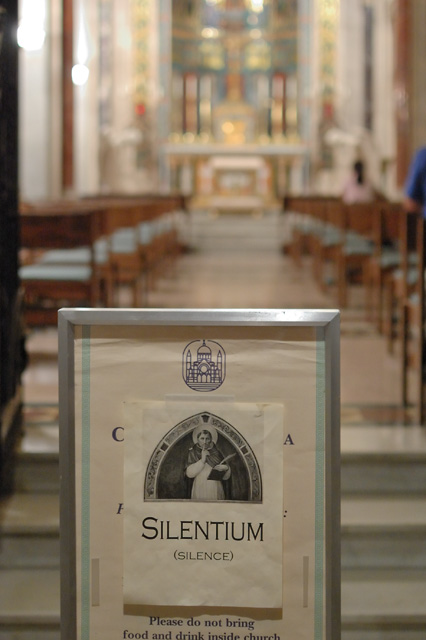
A sign asking visitors to be silent; at the Blessed Sacrament Chapel in the Cathedral Basilica of Saint Louis.
Thursday, September 01, 2011
Subscribe to:
Posts (Atom)












